When Using the Cable Tester
This content is from our CompTIA Network + Video Certification Preparation Course. Commencement training today!
In this video, CompTIA Network + teacher Rick Trader demonstrates how to use cable testers in network environments.
Allow'south look at some tools that we tin utilize to exam our different cables in our surround.
Cable Testers
- Properly Wired
- Connectivity
The start is a simple cablevision tester. Since you may discover yourself creating your ain cables such equally installing our own RJ45 or BNCs ends, we want to brand sure those cables take been correctly wired.
One of the things we can await at is are we properly wired using this cable tester. It also allows u.s. to check connectivity from one end to the other cease.
Let's accept a look at a simple cablevision tester.
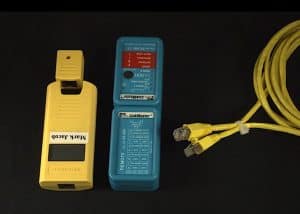
These simple cable testers are inexpensive. Yous tin can option these up at most of your computer shops anywhere you get.
The start one we are going to look at is this blue LinkMaster.

You'll notice on the blue one, nosotros've got a series of cables here and it'southward got lights. It's going to prove u.s. whether or not we're wired correctly. It also shows the states the actual T568‑A and the 568‑B, the actual way the cable should exist wired.
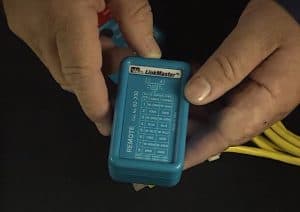
We will plug the ends into the tester (we already know this is a good cable) just we e'er want to make sure we test our cable tester with a known good to brand sure that nosotros are using good cables.
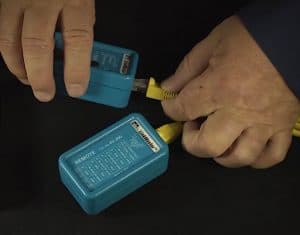
Next we'll push button the push button and it goes out and information technology tests the cable.
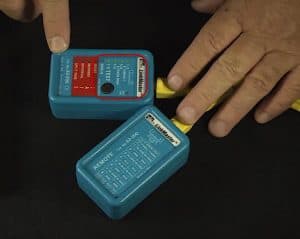
It'southward ensuring that pin i is wired to pin 1 and 2 to 2, 3 are together, 4, 5 etc.
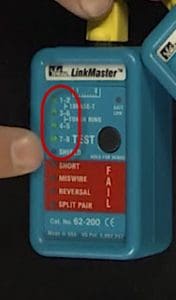
This is a adept test. All it's doing is testing the cable.
This other cable tester does the verbal same affair but it just gives a picayune bit different of a display.
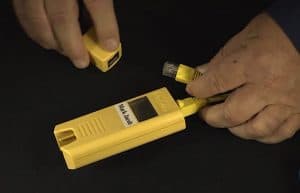
Once more nosotros'll attach the cable on i one cable tester and detect it comes out and it shows me that pin 1 and ii, iii,4, 5, etc… all the way through to ensure they're all wired correctly.
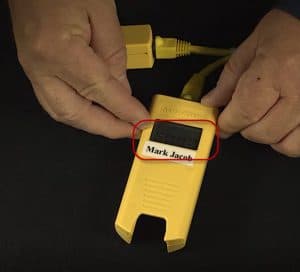
This is a known skillful cable.
Now permit's await at another practiced cable but now it's actually a crossover cable. I know that past looking at the wiring cables.
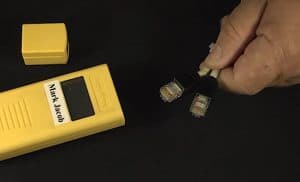
We will plug this into the cable tester and turn information technology on.
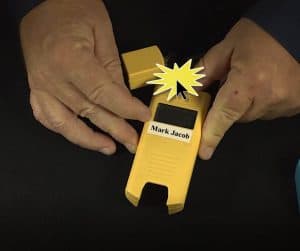
When plugged in, it starts flashing. Information technology says, "Hey, I've got an open."
On this crossover cable, pins 4 and 5 are not wired, likewise find that one and 3 have been swapped, ii and half-dozen have been swapped, and 2 and vi on the other cease one and 3 have been swapped. It'south showing us that this is actually the crossover cable. It shows information technology as a bad cablevision.
If I utilise the original elementary tester, notice it it informing us that nosotros accept a bad cable.
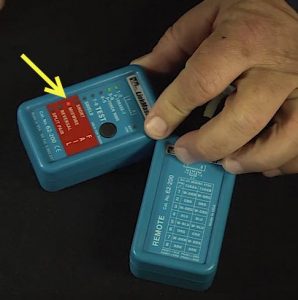
1, ii and 3,vi are not detected and 4,five,6,vii, and 8 aren't even wired correctly at all.
In this particular one, the cables iv and five weren't fifty-fifty wired. It's showing me that I accept a miswired cable. This allows me to get over again. Information technology allows me to go in and test my cables and exist out to expect at things correctly.
Wire Mapper (Certifier)
- Connectivity
- Attenuation
- Crosstalk
A wire mapper is sometimes referred to as a certifier. What a wire mapper tin can do is the same thing a cable tester can do. Information technology can exam my connectivity.
For example, we tin can put a loopback on one end and connect the wire mapper on the other terminate. It will test connectivity. It's going to test to brand sure I'thousand wired correctly.
Attenuation:
The other things it can do is exam the wire for attenuation. That ensures that I don't have too much signal driblet from the time from one stop to the other end. A lot of times if the wire goes out of specifications, by running cables longer than we are allowed to, you'll see that attenuation drops. As a consequence, nosotros'll get inconsistent information transfer.
Crosstalk:
Information technology as well is going to bank check for crosstalk. Crosstalk for example can exist caused by untwisted wires when the patch console was built or bad connectors can cause crosstalk.
We tin as well be getting crosstalk because of the way the cable in the cable feed. Then the wire mapper, is more than expensive the simple testers simply information technology as well provides more testing options.
Loopback Adapter
- Verify End-to-End Connectivity
The next type of device we can use is called a loopback adapter. What a loopback adapter does is it takes pivot 1 through 8 and will take pin one and pin iii and ties them together.

Further, information technology will take pin 2 and 6 and ties them together.
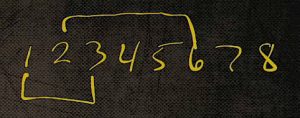
Finally is will take pin 4 and 5 together and so seven and viii together.
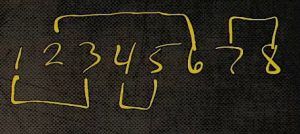
What this is really going to practice is it's going to constitute a loopback. This is what you'll unremarkably see at a store. Information technology'southward just a uncomplicated one.
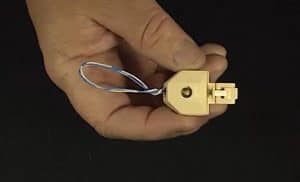
If nosotros were to unbolt this, you'd see that pivot one and three are connected to each other. What nosotros tin can do is plug this in and really verify that nosotros get a link light. It will show that our network adapter carte du jour is beingness useful.
Here's ane that we made.
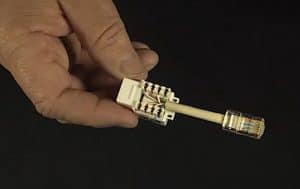
Nosotros took an RJ45 connector with a little piece of twisted pair cabling and so we twisted with 1 and three being connected, ii and 6 being connected, iv and 5 and 7 and 8 being continued.
Again we can plug this into the back of the auto or we can plug this into a cable and establish a loopback.
Finally, some of the lilliputian more expensive ones. If you look on here, information technology tells you actually how it'south looped back on the sides.
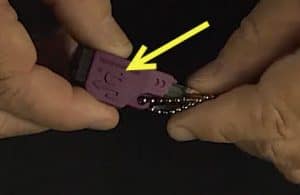
This is actually designed so that we can plug into the back of the figurer to provide a loopback to the network adapter card ‑or we can plug this on the end of a cable and provide a loopback on the end of the cable.
These are only different vendors, dissimilar means they make the loopback adapters.
Multimeter:
- Check Connectivity
- Voltage
- Shor vs Open
The next device that nosotros might use in our environment is called a multimeter. Traditionally, near people are going to be using multimeters to cheque for voltage whether it be Air conditioning voltage or DC voltage. They might be checking AC voltage and making certain that the outlet is wired correctly, or making sure that an extension cord is working correctly or a power panel is working correctly.
DC can be used to check the voltage of possibly your CMOS battery or a bombardment that you lot might have in your surround or even the battery from your laptop.
We can too use a multimeter to bank check connectivity. Commonly a multimeter is used to bank check if a cable is shorted. Such as when the center conductor is making connectivity with or touching my footing. We too can be checking information technology to make sure the wire hasn't been cut or there's an opening in it.
Let's expect at how this is actually used.
Here is a standard multimeter.
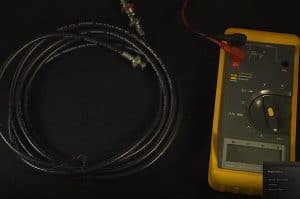
We use this with a coaxial cable because it's a lot easier to examination it with. Traditionally nosotros are going to use the diode mode. (If y'all got a good Fluke meter or a proficient multimeter, they volition have a diode mode.)

When working with a diode, y'all put the leads one way, you lot don't become a sound, if you put the leads the other way y'all'll become a sound that tells you that the diode does non have a short or the diode hasn't opened or been damaged.
We can take the conductor and get to basis on the outside. Then we attach it to the middle usher in the middle.
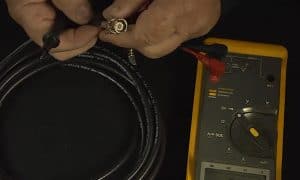
We should not hear tone. If at that place is a tone it means we accept a brusk in the cablevision.
This ways that somewhere forth the run this cable is either been crimped (for example, someone may have closed it in a door or it may be upward in the ceiling and been crimped upwardly at that place) but somehow, the centre conductor is probably touching the outer conductor.
If we exam from one finish of this cable to the other finish of this cable to make sure there's connectivity. We can get back to the end of the cable and simply put a terminator on it.
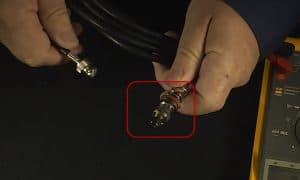
Then test the other cease of the cable and we want to hear a tone.
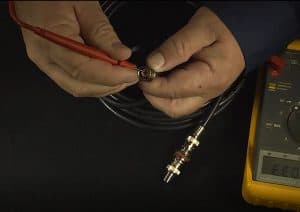
We will connect it to the outer shield and to the middle. We should at present hear a tone.
If we did non hear a tone that means that this cable is open. Somewhere in the centre, this cable has a pause. It could be a break on the shielding, information technology could be a break with the center conductor, it could actually exist cut. At that betoken now we're troubleshooting, why we have an opening on the cablevision.
The last thing nosotros can do with a multimeter is to attach a terminator to ane terminate and check the ohms in this terminator, because remember, that when we are using a coaxial cable, we have to accept a terminator on each end and the terminator has to match the cable.
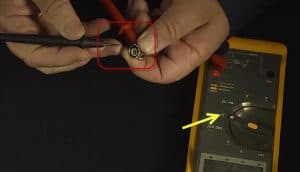
Again, bear on the exterior of the terminator, get to the eye conductor and measure the ohms in the terminator. Now, this is an actual 50‑ohm terminator. This will be bad because go along in mind, on an RG6 or an RG59 coaxial cablevision, we need to exist running a 75‑ohm terminator, not a 50‑ohm terminator. This was actually for RG58 cable which is some of the older cables. That'southward really using a meter or a multimeter.
Tone Generator and Probe (Play tricks and Hound)
- Trace Cablevision End-to-End
The next device we might use is referred to as a tone generator. This tone generator commonly is referred to as a fox and hound. At one finish of the cable we tin attach what they refer to as the pull a fast one on.

And so use the probe which is going to be the hound and find this cablevision. Let'due south say, for instance, we have a cable run that has 50 cables in information technology. We don't know which cable is the cable that the target merely the tone generator can be used to find it.
Here is an example of a tone generator with a play a joke on and hound.
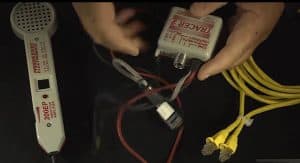
We can connect information technology to i stop of the cablevision.
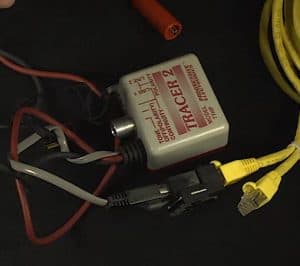
Let's assume that this cablevision isn't tied together like it is in the image. We wouldn't be able to run across the other end considering it could run through the wall. Nosotros now tin plough on the tone generator and then use the probe or (the hound) in order to locate it.
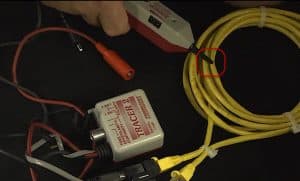
What nosotros will practise it touch each of the cables in that cable run until y'all hear a buzz. The tone allows us to discover that individual cable inside that big parcel of cables.
Personal story. I have a cablevision run that runs through my garage at habitation for our cablevision system. I didn't run it. I took this Tone Generator and Probe home and connected it to my F connector in the garage and and so went out to the cable box and used the probe and touched each cable until I found the cable that I had connected to and found that cable wasn't connected at all. I could've done i cablevision at a fourth dimension where to connect the Goggle box until I did it that fashion. This immune me to find that cable. Again, this is a handy environment especially if you are looking for a damaged cablevision from one end of the other.
TDR / OTDR
- Time Domain Reflectometer
- Optical Time Domain Reflectometer
- Distance of the Cable Run
The side by side tool is called a time‑domain reflectometer. There's are two types. There'due south a TDR for testing copper, twisted pair or coaxial, and so the OTDR is optical time‑domain reflectometer which is used for testing fiber.
A TDR or an OTDR, it's used to determine the altitude of a cable run.
If you are certifying cables, information technology allows u.s. to make up one's mind the distance.
We attach a TDR to one end of the cablevision. And so nosotros volition tell the program what type of cable information technology is such as twisted pair, coaxial, or cobweb. If it's fiber, we volition tell is it single‑style fiber or is it multi‑fashion fiber. So nosotros will plug that into the TDR until you hear a pulse. It'southward either going to be a light pulse or a sound wave. It pings down the cable.
Now information technology goes down the cable and when it gets to the break…Think almost the break, it'due south kind of you're at the Great Canyon you holler, "Hello." You lot wait for a few seconds and you hear the hi dorsum. When I get to the end of the cable, I'm going to get an echo. Remember that's why we take terminators on our coaxial cable to prevent this echo or bounce dorsum.
Now, when it gets back to the TDR, the TDR knows what type of cablevision you had so it does a ciphering on time. How long did information technology take that point to travel down the cable and back? Then it can it compute the distance to where that pause is.
This is used to find breaks in cables. It's also used to be able to go in and certify our altitude of our cables inside of our buildings.
We looked at some of those mutual tools that nosotros utilise to test cables inside of our surroundings.
Until next time….
Rick Trader
CompTIA Network + Teacher – Interface Technical Training
Phoenix, AZ
Video Certification Grooming: CompTIA Network +
Source: https://www.interfacett.com/videos/cable-testers-and-how-to-use-them-in-network-environments/
0 Response to "When Using the Cable Tester"
Post a Comment